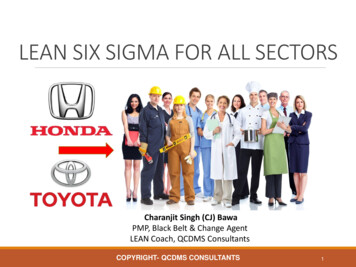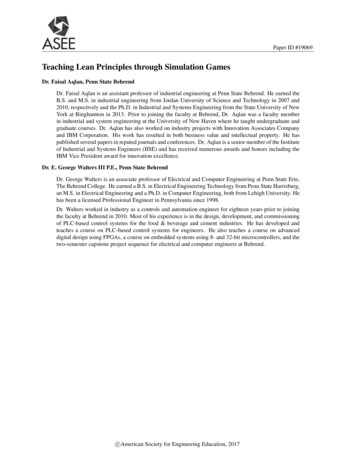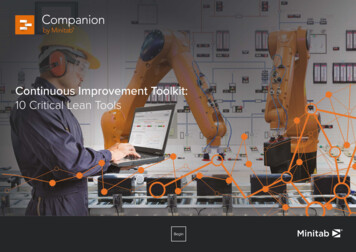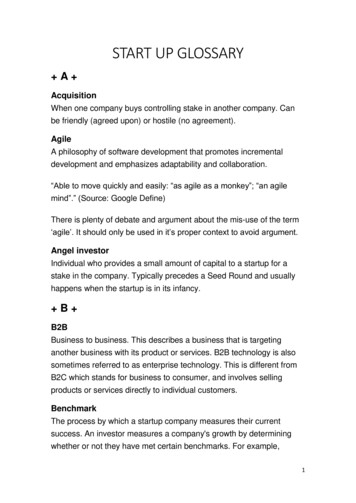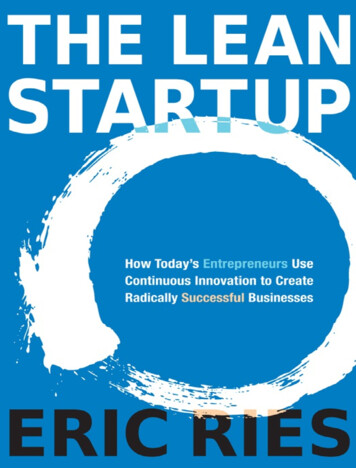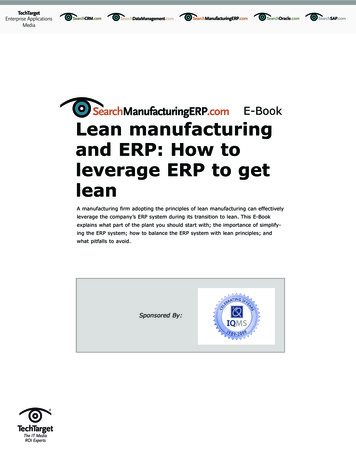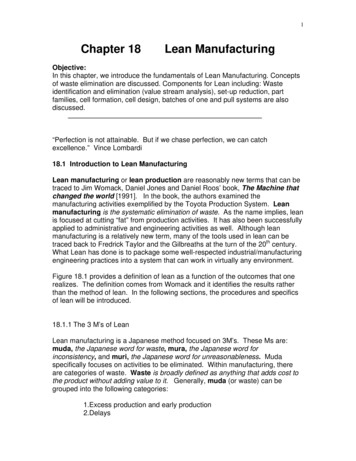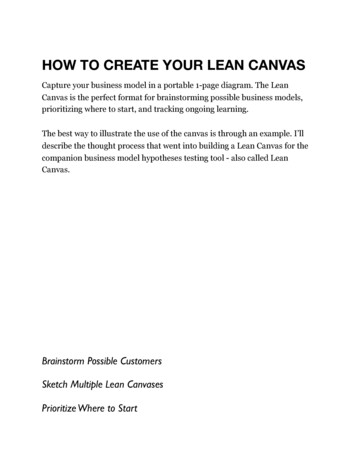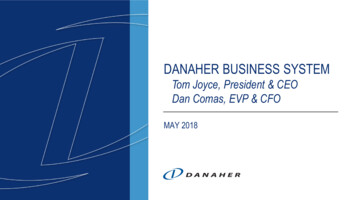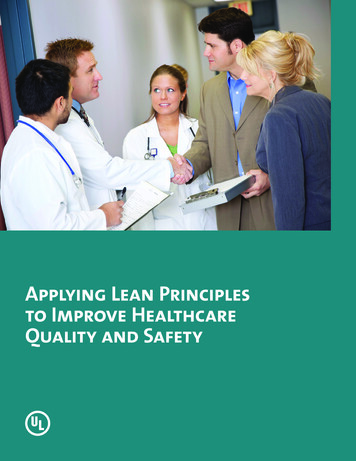
Transcription
Applying Lean Principlesto Improve HealthcareQuality and Safety
Applying Lean Principles to Improve Healthcare Quality and SafetyApplying Lean Principles toImprove Healthcare Quality and SafetyAs a percentage of its gross domestic product (GDP), the U.S. spends more on healthcarethan any nation in the world. According to a 2012 report from the Organization forEconomic Cooperation and Development (OECD), the U.S. annually spends 17.6% of itsGDP providing healthcare services. This compares with 12% for the Netherlands, thecountry with the second largest annual spend on healthcare services as a percentageof GDP, and an average of just 9.5% of GDP for other OECD countries.1At the same time, the rising cost of healthcare has not directly resulted in betterpatient care or improved patient outcomes. According to the same OECD report data,while average life expectancy in the U.S. has increased by almost nine years since 1960,the current U.S. average of 78.7 years is a full year below the OECD country averageof 79.8 years. Further, according to a landmark study conducted by the Institute ofMedicine, preventable medical errors are estimated to result in as many as 98,000patient deaths each year, with a projected annual cost as high as 29 billion.2 Medicalmistakes are believed to be one of the leading causes of death in the U.S., on a par withautomobile accidents, breast cancer and AIDS.In this context, healthcare institutions and professionals are exploring innovativeapproaches and methods that reduce preventable medical errors, improve patientcare and safety and decrease healthcare costs. Increasingly, healthcare institutions areimplementing lean operational principles and practices pioneered at Toyota and otherindustrial companies in the 1990s. By applying lean methodologies to existing systemsand procedures, major healthcare institutions are achieving significant improvementsin patient safety while also reducing costs.This UL white paper provides an overview of the application of the lean continuousimprovement framework in the healthcare environment. The paper begins witha discussion of the issues and challenges facing healthcare institutions related topatient safety. The paper then presents a brief history of lean principles as appliedat Toyota and other industrial companies, before moving on to a review of the leanframework and its application. The white paper also offers brief summaries of specifichealthcare cases in which lean methods have been implemented and concludes witha business case for continuous improvement and innovation.page 2
Applying Lean Principles to Improve Healthcare Quality and SafetyIssues and Challengesin Healthcare TodayNo other industry places as higha premium on quality of service ashealthcare. Leading companies inother industries often boast that theirservice quality differentiates them fromcompetitors. But only in healthcare doesquality of service have a direct impacton the health and safety of those served.Indeed, service quality that does notmeet the minimum required standardsof healthcare providers can mean thedifference between life and death.Given the essential requirement ofquality of care in the healthcare industry,one would reasonably expect healthcareproviders to lead the way in initiatingand maintaining effective qualitymanagement systems. In fact, healthcareindustry leaders have worked for decadesto improve patient care through a myriadof quality programs. Unfortunately, manyof these quality improvement effortshave fallen short of expectations.One measure of this shortfall is thehuman and financial cost from deathsand illnesses attributable to medicalerrors. According to one study,approximately 200,000 Americans dieeach year from preventable medical errorsand facility-acquired illnesses, at a directcost of nearly 20 billion. In addition, thebroader economic impact from medicalerrors may well approach 1 trillionannually when lost economic productivitydue to death or illness is calculated.3The healthcare environment is alsoincreasingly unsafe not just for patientsbut for healthcare workers as well.In 2011, one of out every 20 full-timeU.S. healthcare workers experienceda nonfatal injury or illness, an incidentpage 3rate second only to workers in agriculture,forestry, fishing and hunting occupations.During that year, healthcare workersreported more than 631,000 incidentsof injuries or illnesses in connectionwith their work.4 One estimate putsthe cost of worker injuries and illnessesin the healthcare workplace at over 10 billion annually.5These and other statistics clearly illustratethe human and financial consequenceswhen healthcare institutions fail toconsistently deliver the highest possiblequality of care to patients. They alsohighlight some of the inherent limitsin healthcare’s traditional approach toquality management. These limits include:a reliance on a host of individual projects,rather than a coordinated system-wideapproach to quality management;a quality strategy formulated and handeddown from senior management withoutinput from the employees responsiblefor service delivery; and the failure toproperly align an institution’s approachto quality management with itsmission and strategy.The American healthcare industry iscurrently undergoing an unprecedentedtransformation, as healthcare providersare actively engaged in efforts to bringtheir practices into compliance with therequirements of the 2011 Patient Careand Affordable Care Act. As a result,healthcare providers are under pressureto increase access and reduce costs whileimproving the quality of patient care.Successfully overcoming the limitationsof legacy quality programs while alsoaddressing today’s challenges requiresnew approaches to quality management,approaches that can directly lead to betterquality of care through improved workflow and increased operating efficiencies.UL’s Involvement in LeanAs part of its commitment to assist healthcareorganizations in the application of leanprinciples and practices, UL has establishedthe Center for Continuous Improvement &Innovation (CCII). The Center trains, certifies,assesses and advises organizations andindividuals in the principles of continuousimprovement, leveraging years of experiencein the application of lean and Six Sigmaprinciples to accomplish one mission: improvevalue for the customer by providing higherquality and safety with less waste.To further the mission of the CCII, UL hasalso formed strategic relationships withother organizations championing the use oflean principles in healthcare. For example,UL has partnered with the ThedaCare Centerfor Healthcare Value to sponsor ToyotaProduction System (TPS)/Lean in Healthcareresearch. UL is also a sponsor of the HealthcareValue Network, a consortium of healthcareproviders committed to providing high-quality,cost-effective care through the applicationof lean concepts.UL also collaborates with Value Capture,a leading healthcare advisory firm foundedby Paul O’Neill, former secretary of the U.S.Treasury and former CEO of Alcoa. ValueCapture’s proprietary advisory model forhealthcare institutions has resulted insignificant reductions in healthcare workplaceinjuries and illnesses while speeding thedelivery of services and eliminating waste.The collaboration between UL and ValueCapture strengthens UL’s existing advisoryservices by providing UL customers with accessto a proven quality and safety improvementmodel based on lean principles.Finally, UL is an authorized educational partnerof The Shingo Prize for Operational Excellence,a not-for-profit organization located at UtahState University working to establish the globalstandard of excellence in every industry. TheShingo Prize is named in honor of Japaneseindustrial engineer Shigeo Shingo, one ofthe world’s thought leaders on the ToyotaProduction System.Lean principles are an essential element ofUL’s own operations and activities. Current ULPresident and CEO Keith Williams initiated theorganization’s first lean initiative in 2005 toimprove the quality and timeliness of serviceto its customers. Today, professionalsthroughout UL embrace lean principles aspart of a continuous improvement philosophythat has strengthened the organization andbenefited its customers and employees.
Applying Lean Principles to Improve Healthcare Quality and SafetyThe Origins of Lean PrinciplesModern quality management programsare rooted in pioneering researchconducted more than 100 years agoby Americans Frederick Winslow Taylorand Walter Shewhart. Taylor focused onstudying existing workflow processes,experimenting with alternative processesthat removed unnecessary or inefficientactivities and adopting those processesthat resulted in consistent productionquality and improved worker productivity.Shewhart was the first to implementstatistical process control, a qualitycontrol method in which data areregularly analyzed in order to identifyanomalous production patterns.Many of the efficiency assessmentmethods championed by Taylor andimplemented by automotive iconHenry Ford in the U.S. were studiedby manufacturers in other countries,including Sakichi Toyoda, a Japaneseentrepreneur and textile manufacturer.Toyoda’s efficiency investigations werelater applied by his son, Kiichiro Toyoda,the founder of Toyota Motor Corporation,initially in the 1930s and especially inthe late 1940s and 1950s. Around thesame time, Edwards Deming, an advocateof Shewhart’s quality control theories,was invited to Japan by the JapaneseUnion of Scientists and Engineers to trainengineers and managers on statisticalprocess control methods. Deming laterworked with a number of Japanesecorporations and lectured extensivelyin Japan, resulting in the widespreadapplication of these principles.At Toyota, it is Taiichi Ohno who iswidely credited with developing theToyota Production System (TPS) in the1950s and 1960s. Based largely onShewhart’s and Deming’s productionpage 4efficiency principles, the TPS isa comprehensive, systemic approach tomanufacturing that reduces or eliminateswaste and production inconsistencies tomaintain or increase value to customers.The TPS also embraces a number ofunderlying principles, including thevalue of organizational learning as a toolfor fostering continuous improvement.The principles and practices collectivelyknown as lean production (or lean,for short) are largely derived from thephilosophy and approach embodiedin the TPS.The promise of more efficient productionwith reduced overhead costs has spurredinterest in lean principles for more than20 years, and lean thinking has beensuccessfully adopted and adapted bya wide range of international corporationsat facilities worldwide. Increasingly,lean principles and practices are beingapplied in non-production environmentsas diverse as software developmentand education. More recently, efforts tointroduce lean principles in healthcarehave gained considerable traction, ashealthcare institutions and providersseek initiatives that move beyond thelimits of traditional production efficiencyor quality management programs. Indeed,lean initiatives in healthcare offer thepotential to achieve quality of careobjectives, improve patient and workersafety, speed delivery of medicalservices, and lower costs.Lean in PracticeAt its core, the lean approach focuses oncustomer value by improving processes toreduce waste and eliminate inefficiencies.Regardless of the specific setting inwhich a lean thinking is espoused, theapplication of lean is based on thefollowing five defining principles:1. Specify value — Define valuefrom a customer’s perspective.Learn what a customer values,and how their experience couldbe improved to support thebest outcome.2. Identify value stream —Evaluate how all the steps ofa process or procedure shouldbe organized to deliver a seamlesscustomer experience; eliminateany steps that do not directlycontribute to achieving that goal.3. Flow without interruptions —Whenever possible, eliminatewaste between steps of a processso that a product or service isdelivered as efficiently as possible.4. Customer “pulls” services —Allow the customer to receiveor request products or servicesif and when needed; do notpush a product or service thata customer is not ready to receive.5. Pursue perfection —Continuously adapt to anever-changing environment andcustomer needs in order to delivera product or service of the highestpossible quality.The application of lean principlesdepends on an organization’s commitmentto continuously improving the valueprovided to a customer. In practice,a lean improvement system usesscience-based problem-solving methodsto identify root cause issues, and appliesimprovement tools to create newstandard procedures that reduce wasteand improve quality. The effectivenessof new procedures is monitored to assessresults and changes are incorporated tofurther improve the process.
Applying Lean Principles to Improve Healthcare Quality and SafetyThe most successful lean initiativesare: systematic and not project driven;implemented by employees coachedby organization leaders and not staffexperts; and consistent with anorganization’s mission and strategy,rather than a reaction to a specificcondition or event. Taking thisapproach, the application of leanprinciples contributes to the creationof an organizational culture in whichcontinuous improvement is the ruleand not the exception.An essential element of an effective,lean-driven culture is lean leadership.Lean leadership is the commitment ofan organization’s leaders to empowerits employees to continuously identifyand implement changes that willimprove customer value. In the mostsuccessful examples, lean leadershipstarts at the highest levels of anorganization and requires a willingnessto ask questions rather than provideanswers so that others can develop andimplement effective and lasting changesbased on their direct experience. Leanleadership also requires an ongoingcommitment to training and developmentso that all employees have the knowledgeand the skills necessary to identify rootcause issues and to implement changesthat improve value. Finally, lean leadersmust make sure that the mission andvalues of their organizations are alignedwith the goal of increasing customervalue through continuous improvement.Lean Results in HealthcareLean principles and practices are beingsuccessfully applied in daily processesused by healthcare leadership and staffat a number of healthcare institutions.In one urban hospital, for example, leanpage 5principles have been applied as partof an effort to eliminate medicationerrors. The hospital estimated thatnearly one-third of pharmacy staff timewas spent resolving problems relatedto incomplete, unclear or illegiblemedication orders, placing patientsat risk and costing approximately 155,000 per year just to clarifyproblem medication orders.changes have dramatically reduced theIn this instance, the application of leanprinciples resulted in process changesto post-operative and medicine unitorders. These changes have reducedthe average amount of time requiredto process a medication order to lessorders has been reduced by 42%. Thesethan five minutes. More important, thevalue-added activities.6number of medication orders placedon hold for further clarification, from2% of all orders to just 0.02%. Problemswith post-operative medication ordershave dropped from 34% to 10%,thereby decreasing the amount of timepatients wait to receive medicationfollowing surgery. And the percentageof unclear post-operative medicationimprovements have also resulted ina reduction in the time hospitalpharmacists spend resolving problemswith medication orders, allowingthem to focus more time on
Applying Lean Principles to Improve Healthcare Quality and SafetyIn another case, a Florida dental practiceapplied lean principles as part of itseffort to reduce patient and clinician waittimes. As a result of its lean initiative, thepractice reports an average 79% reductionin the number of visits and a 95%reduction in the time required to returna patient to full health. These changeshave allowed the practice to increase by35% the number of patients seen whilealso reducing treatment rooms and staffrequirements by 40% (achieved withoutlayoffs). And clinicians have seen theiravailable time increase by 82% ona weekly basis, allowing them tospend time with new patients.7Here are summary results from selectedother lean healthcare initiatives:8 A children’s hospital applied leanprinciples to empower their staffto eliminate activities that didnot add value to the patientexperience, reducing costs byover 8 million during a twoyear period, while shrinkingappointment access waitingtimes by nearly 75,000 days. A breast cancer screeningcenter used lean practices toimplement an interdisciplinaryapproach to screening, diagnosis,biopsy and treatment processes.The changes reduced from 10%to 5% the patient call back ratefor unnecessary biopsies, and35% reduction on breastbiopsy-related costs. Emergency room employeesat nine northern Virginia hospitalsused lean principles and practicesto reduce emergency room waitingtimes. The consortium reportedpage 6a 31% drop in average waiting time,and a four-fold reduction in thenumber of patients who left theemergency room without beingseen by a medical professional. A Midwestern hospital deployeda lean implementation team toredesign the hospital lab process,consolidate redundant equipmentand reconfigure personnel roles.The changes resulted in a 53%improvement in turnaround timefor patient blood test results andnearly 500,000 in annual savings.A Business Casefor Lean in HealthcareAs these cases illustrate, the applicationof lean principles and practices inhealthcare settings can dramaticallyimprove the delivery of patient servicesand the quality of patient care. But leaninitiatives in healthcare can also provideimportant business advantages forhealthcare institutions, including thefollowing benefits: Improved patientoutcomes — Lean initiatives canincrease value for patients byproviding better healthcare servicesthat more effectively treat medicalconditions and reduce rates ofrecurrence. Such results canprevent unnecessary readmissionsand the associated added costs orreduced reimbursement rates. Increased patientsatisfaction — Patients arebecoming more knowledgeableconsumers of healthcare services.Satisfied patients are more likely toremain with healthcare providerswho provide quality services ina timely manner and are less likelyto change healthcare providers. Reduced operating costs — Leaninitiatives typically result in greateroperating efficiencies that leadto reduced staffing and facilitiesrequirements. Employees canbe deployed to perform morevalue-added functions andfacilities can be redesigned tooffer new or expanded services. Stronger financialperformance — By increasingproductivity and reducing costs,healthcare institutions can achievestronger financial results, therebybuilding a more solid financial baseand providing financial resourcesfor further investment. Greater employeeengagement — Lean initiativesdepend on empowering employeesto increase patient value.Empowered employees are moreengaged, and are likely to exhibithigher levels of job satisfaction.These results can lead to increasedemployee retention and reducedturnover rates.Unlike other quality initiatives,improvement efforts based on leanprinciples are not capital intensive.Instead, they are built on alignmentof an entire workforce focused oncontinuously improving patient value.Successful lean initiatives stimulateservice improvements that benefitpatients as well as the healthcareinstitution and its employees, often withlittle or no direct financial investment.
Applying Lean Principles to Improve Healthcare Quality and SafetySummary and ConclusionThe business of healthcare is undergoing a significant transformation as healthcareinstitutions and leaders seek innovative ways to improve quality of service and reducecosts. Traditionally applied in production settings, lean principles and practices arenow being implemented in non-production related settings including healthcareenvironments. Lean offers significant advantages over legacy quality improvementmodels by increasing efficiency and reducing waste while simultaneously improvingquality of patient care. With its focus on increasing value, lean has the potential to helpbalance the cost associated with healthcare, increase the job satisfaction of healthcareprofessionals, and fundamentally improve the health of our communities.For additional information about UL’s lean advisory services, contact Juan Amador,Director, Continuous Improvement, UL Knowledge Services at juan.amador@ul.com.1“U.S. Healthcare system from an international perspective,” PowerPoint presentation of OECD Health Data 2012, June 28, 2012.Web, January 21, 2013, thSpendingInUSA HealthData2012.pdf.2“To Err is Human: Building a Safer Health System,” Institute of Medicine, November 1999. Web, January 21, 2013, http://www.iom.edu/ f.3“The Economics of Health Care Quality and Medical Errors,” Charles Andel, Stephen L. Davidow, Mark Hollander and David A. Morenofor Wolters Kluwer Law & Business, October 15, 2012. Web, March 4, rs/,4“Workplace Injuries and Illnesses - 2011,” News Release, Bureau of Labor Statistics, U.S. Department of Labor, October 25, 2012.Web, April 11, 2013, ime employee injuries cost healthcare billions,” Knowledge at Work, Underwriters Laboratories, January 14, 2013.Web, February 11, 2013, injuries-cost-healthcare-billions/.6“Client Success Stories,” ValueCapture, LLC. Web, May 31, 2013, http://valuecapturellc.com/success.html.7“A Trip to the Dentist That You'll Enjoy,” Lean Enterprise Institute, November 3, 2009.8“Success Stories,” ThedaCare Center for Healthcare Value. Web, March 19, 2013, s/.Web, May 31, 2013, http://www.lean.org/shook/displayobject.cfm?0 1318.UL and the UL logo are trademarks of UL LLC 2013. No part of this document may be copied or distributed without the prior writtenconsent of UL LLC 2013.page 7
Lean in Practice At its core, the lean approach focuses on customer value by improving processes to reduce waste and eliminate inefficiencies. Regardless of the specific setting in which a lean thinking is espoused, the application of lean is based on the following
